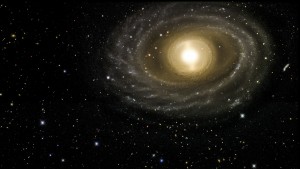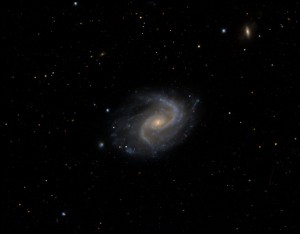“Art of Darkness,” a new show featuring images from the Dark Energy Camera, runs through April 29, with an artists’ reception planned for March 18 from 5-7 p.m.

This image of the NGC 1398 galaxy was taken with the Dark Energy Camera. This galaxy lives in the Fornax cluster, roughly 65 million light-years from Earth. It contains more than 100 billion stars. Photo: Dark Energy Survey
Imagine being able to see 8 billion light-years into space. Imagine feeling like you are near enough to another galaxy to count its spiral arms or close enough to a comet to reach out and touch it. Imagine being given a window onto the vast magnificence of the universe, without leaving Earth.
With the Dark Energy Camera, a stunning scientific instrument built and tested at the U.S. Department of Energy’s Fermilab, we can. Even better, we can capture images of the cosmos in digital quality. For the past three years, scientists have been using the camera, mounted on a telescope in the Andes Mountains in Chile, to learn more about dark energy, the mysterious force scientists think is pushing the universe apart faster and faster.
In order to do that, scientists using the camera are taking some of the most breathtaking pictures of galaxies, nebulae and other objects ever seen. And now you can see them too, as the Fermilab Art Gallery presents “Art of Darkness – Images from the Dark Energy Survey,” a new show featuring images taken with the Dark Energy Camera. The exhibit features more than a dozen dazzling photos of stars, galaxies and celestial objects (including one comet that snuck its way into frame), alongside pictures of the Cerro Tololo Inter-American Observatory, where the camera lives.
“The Dark Energy Camera is one of the best scientific instruments of its kind,” said Brian Nord, one of the Fermilab particle astrophysicists who processed many of the images that make up the show. “It not only takes amazing images of the cosmos, but it gives us valuable data to learn more about that cosmos and crack one of the main mysteries of the universe.”
The universe has been expanding since the Big Bang nearly 14 billion years ago, and that expansion is accelerating. Scientists on the Dark Energy Survey, a five-year experiment using the Dark Energy Camera, will be using these images (and millions like them) to learn more about just what is causing that expansion.
The images that make up “Art of Darkness” are the end result of a collaborative process that begins with observers and telescope operators in Chile, pointing the camera at specific parts of the night sky. Those images are digitally transferred to the National Center for Supercomputing Applications at the University of Illinois for processing. Each image taken with the camera contains about a gigabyte of information, and each picture you see on display is actually five of those images combined, each taken using a different color filter.
“It takes a lot to combine those five images into something that pops off the screen,” said Fermilab’s Martin Murphy, who collaborated on processing many of the photos in the exhibit. “But looking at the complete picture is always worth it. I’m blown away each time.”

Spiral galaxy NGC 0895 is located in the constellation Cetus, about 110 million light-years from Earth. This image was taken with the Dark Energy Camera, the primary research tool of the Dark Energy Survey. Photo: Dark Energy Survey
The final result is a full-color panorama of beauty. Most of the images in “Art of Darkness” feature a particular galaxy, but look closely and you’ll see thousands of other objects. Many of the light sources in these images aren’t single stars but distant galaxies made of billions of stars each.
“I’m proud and happy to have these images from the Dark Energy Camera on display here,” said Georgia Schwender, curator of the Fermilab Art Gallery. “We often feature art inspired by science, but this is a rare example of science that already is art, and gorgeous art at that.”
“Art of Darkness” is open now and runs through April 29. The Fermilab Art Gallery is open Monday through Friday from 8 a.m. to 4:30 p.m. An artists’ reception for “Art of Darkness,” featuring scientists from the Dark Energy Survey talking about the selected images, will be held on Friday, March 18, from 5-7 p.m. The exhibit and the reception are free of charge.
The Dark Energy Survey is a collaboration of more than 400 scientists from more than 30 institutions in seven countries. Its primary instrument, the 570-megapixel Dark Energy Camera, is mounted on the 4-meter Blanco telescope at the National Optical Astronomy Observatory’s Cerro Tololo Inter-American Observatory in Chile, and its data is processed at the National Center for Supercomputing Applications at the University of Illinois at Urbana-Champaign.
Fermilab is America’s premier national laboratory for particle physics research. A U.S. Department of Energy Office of Science laboratory, Fermilab is located near Chicago, Illinois, and is operated under contract by the Fermi Research Alliance LLC. Visit Fermilab’s website at www.fnal.gov, and follow Fermilab on Facebook at www.facebook.com/fermilab and on Twitter @Fermilab.
The DOE Office of Science is the single largest supporter of basic research in the physical sciences in the United States, and is working to address some of the most pressing challenges of our time. For more information, please visit science.energy.gov.
